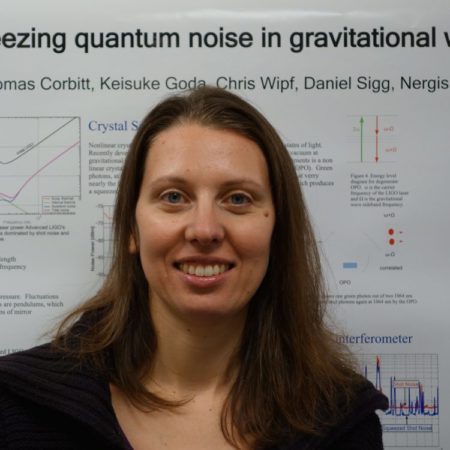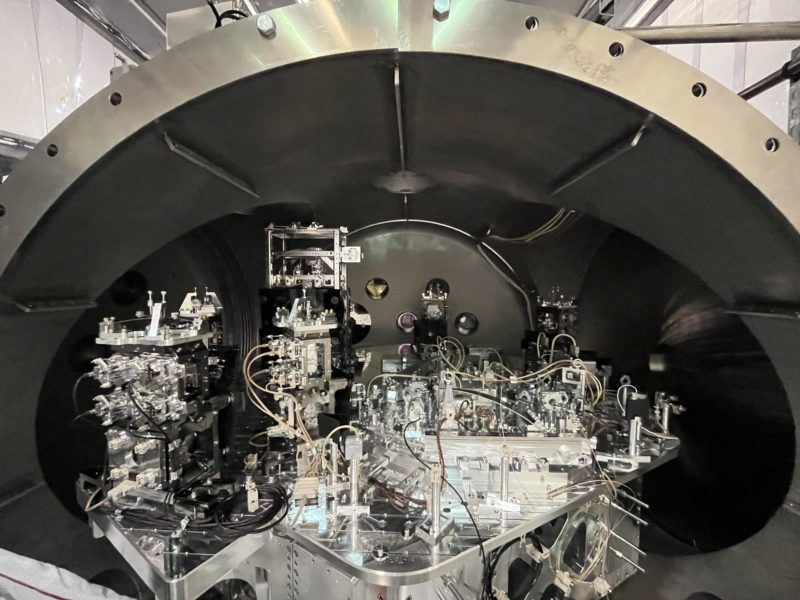
On my watch – The Astounding Astronomical Success of the LIGO Project Detecting Gravitational Waves
By Anne W. Semmes
LIGO is the fourth of five extraordinary astronomical space exploration projects introduced by my astronomer stepbrother Michael Snowden, who lives in New Zealand. LIGO is the acronym for Laser Interferometer Gravitational-Wave Observatory. It is the world’s largest gravitational wave observatory and a marvel of precision engineering. The project is a collaborative effort between the California Institute of Technology (Caltech) and the Massachusetts Institute of Technology (MIT), funded by the National Science Foundation.
There are actually two LIGO observatories, the Hanford one in Washington State and the Livingston one in Louisiana, 3,000 kilometers apart but connecting, each with L-shaped detectors consisting of four-kilometer-long vacuum chambers capable of measuring a motion 10,000 times smaller than an atomic nucleus (the smallest measurement ever attempted by science) caused by the most violent and cataclysmic events in the Universe.
It was in 2015 that LIGO made history with the first direct detection of gravitational waves, or ripples in space and time, produced by a pair of distant colliding black holes. This discovery brought the Nobel Prize in Physics in 2017 to three physicists, Kip Thorne, Rainer Weiss, and Barry Barish for their “decisive contributions” to observations of gravitational waves.
Those ripples in space were predicted over a century ago by the mathematics of Albert Einstein’s general theory of relativity. So, what might have been Einstein’s reaction to this LIGO discovery proving his theory, “I think he would say, well done!” said Dr. Lisa Barsotti, a leading scientist in gravitational waves, at a recent talk.
Dr. Barsotti has dedicated her career to the search for and study of gravitational waves. It began for her in college. “I started to work in this field because while I was studying General Relativity at Pisa University, more than twenty years ago, I realized that a gravitational-wave detector, Virgo, was being built very close to my house! So, I decided to do my bachelor’s degree work on Virgo.” After getting her doctorate Barsotti relocated at MIT as a Post Doc in 2007, where she now serves as a Principal Investigator and Senior Research Scientist on the LIGO project in MIT’s Kavli Institute for Astrophysics and Space Research.
To learn more about LIGO from Dr. Barsotti’s perspective we asked her a few questions.
AWS: Understanding that LIGO’s instruments are able to actually measure the “wobble” [Michael’s term] of a gravitational wave going through the universe, how big is the wobble or the amplitude of the modulation that it’s actually measuring? How sensitive are the instruments for measuring the warping of space-time?
LB: As gravitational waves pass by, they stretch and squeeze space-time, but just by a tiny bit, as the amplitude of gravitational waves is very, very small. So small that to capture this effect, the LIGO instruments must be able to measure displacements on the order of one attometer. Measuring such a small displacement over the 4-km arm length is equivalent to measuring the distance to the nearest star to an accuracy smaller than the width of a human hair!

AWS: So, it was in the late 1960’s that three colleagues began to conceive of this LIGO machine to be located in Washington State and in Louisiana. Where came such extraordinary confidence that this remarkable feat could be accomplished with an inconceivably complex instrument, and that such considerable funds could be obtained to fund it?
LB: At the time the LIGO detectors were conceived, a lot of the technology needed to make the LIGO detectors operate at their design sensitivity had yet to be developed. There were also great uncertainties in what Nature would offer – which and how many gravitational-wave sources LIGO might be able to detect. So, I would say that there was more courage than confidence. It was certainly a high risk, high reward type of investment.
In my personal experience, the fact that the LIGO detectors are such interesting and complicated instruments, pushing the limits of precision measurement, has always been rewarding. Even in the early commissioning days, when we were quite far from detecting gravitational waves, I have always reminded myself that we were making an incredible measurement per se. And even if we could not control Nature, we could control our detectors, and work hard to make them as sensitive as possible.
AWS: Then, with the success of LIGO, it was determined in 2015, I understand, that improvements in the instruments were needed. What percentage of improvements were needed? How long was it offline for its upgrading to be done? How much more sensitive have the instruments become?
LB: The first generation of LIGO detectors did not detect gravitational waves. The first major upgrade, called Advanced LIGO, enabled the first detection of gravitational waves in 2015. At that time Advanced LIGO was operating with approximately 3 times better sensitivity than the initial detectors, with a final goal of reaching a factor 10 better sensitivity. Another upgrade, called LIGO A+, built on top of the Advanced LIGO upgrade to incorporate new technologies was developed in the meantime. Now we are quite close to the Advanced LIGO target, with both LIGO instruments operating at a sensitivity which is twice as better than in 2015.
AWS: How often are new discoveries being made at LIGO now? Such as a collision of two black holes, or collisions of neutron stars? Has this got to the point where they’re discovering one a month, or one a day, or one a year? With the new discoveries that are being made, how often are they actually seeing events that shake the universe and shake LIGO?
LB: LIGO is detecting about two events per week in the ongoing observing run O4, compared to roughly 1 per month in the first observing run O1 in 2015. So quite an improvement!
AWS: So, with LIGO’s success as an American adventure, I understand the European Space Agency has jumped into this big time. They are developing a follow-through from LIGO called LISA (Laser Interferometer Space Antenna) to be a massively more sensitive instrument than LIGO due to be launched around 2030. Their machine will go into orbit spreading across a big piece of the solar system with three modules connected by lasers. What do they expect to get from LISA?
LB: LISA and LIGO cannot be directly compared – they are two very different instruments, LISA will be built in space while LIGO is on the ground, operating in very different frequency bands. They are two complementary instruments which will give us information about different sources of gravitational waves. For example, LISA will be able to detect black hole systems which are much heavier than the ones LIGO can detect.
There are also plans, both in Europe and in United States, to build the next generation of ground-based gravitational-wave detectors based on further improved LIGO technology. The two design concepts are Einstein Telescope in Europe and Cosmic Explorer in United States. If LISA and these new ground-based detectors can be operational at the same time, they will give us access to a variety of gravitational-wave sources throughout cosmic history.
Other experiments are more specifically targeting gravitational waves emitted in the early Universe, like Pulsar Timing Arrays and experiments that look at the Cosmic Microwave Background.
AWS: What will we get out of this fundamental knowledge about nature and how it works? What are the expectations?
LB: Gravitational waves are a completely new way to learn about the Universe, giving access to study events that were invisible to us. The dream is that we will build instruments to target all the different frequency bands, thus giving us access to all of the gravitational wave sources and combine the information to study some of the most cataclysmic events in the Universe throughout cosmic history.
Next up will be the Vera C. Rubin Observatory, an astronomical observatory currently under construction in Chile. Its main task will be carrying out a synoptic astronomical survey, the Legacy Survey of Space and Time.




